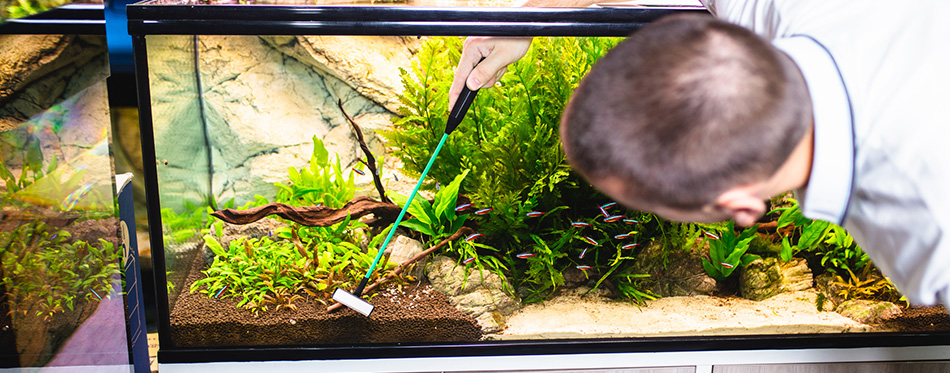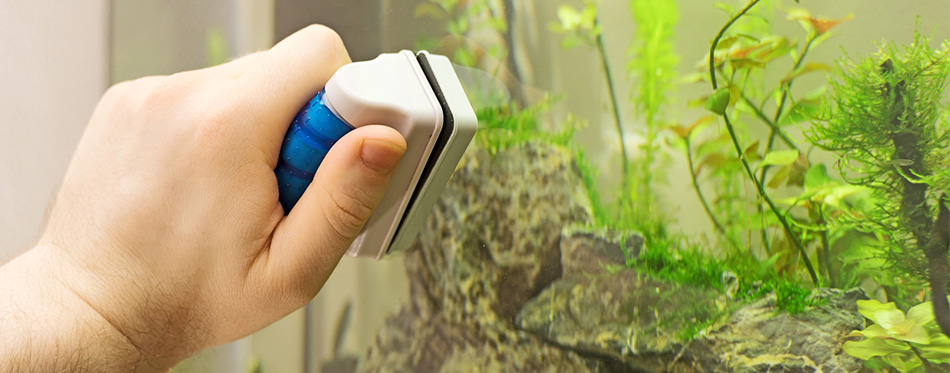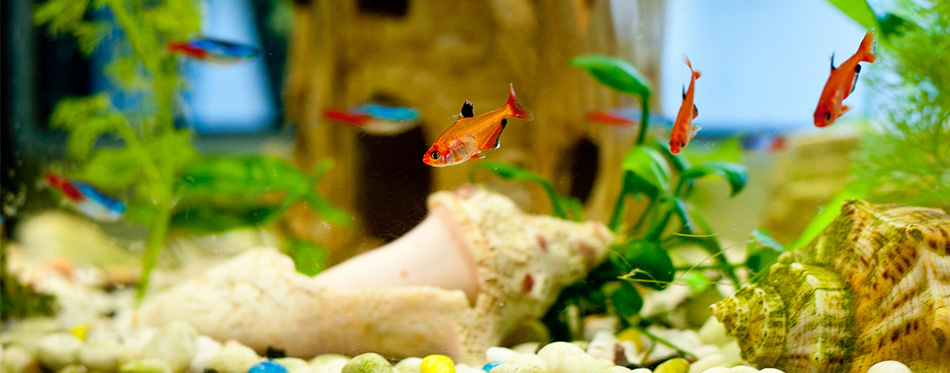If it is becoming increasingly harder to see your cute little goldfish swimming around it its decorated tank, you have already waited way too long to clean your fish tank. Even if your fish tank looks clean at a glance, you needn’t wait until the waters get murky and algae coats the glass before cleaning is done. You might not know it, and even poor fishy can’t complain that it is literally swimming and drinking up its own dirt. Not sure how to go about the aquarium cleaning? Read on as we share some tips on how to properly clean a fish tank to have that tank spick and span in no time.

Evacuate Fishy!
Although you can wash your fish tank with goldy still inside, however, getting it out makes more a more thorough wash without getting fishy overly stressed. You could scoop out a bowl of the pre-cleaning tank water, take out your fish using a net and keep it in the bowl until you are done with cleaning. Just make sure not to remove fishy every time you have to clean the fish tank. Fishes tend to get easily stressed and fall sick. This same method could be used even when cleaning the larger fish tanks used by those who breed fish for sale.
Get Your Equipment Ready
When you already got fishy bothered and out of its comfort zone in anticipation of a cleaned tank is certainly not the time to start fumbling around looking for your cleaning tools every which way. To properly clean that fish tank, you will be needing clean water to replace some of the dirty ones. Tap water treated with a water conditioner will do. An algae scraper will be needed for cleaning the glass of the fish tank, a siphon vacuum, a fish tank safe glass cleaner, filter cartridges, a gravel vacuum, a thermometer, a salinity probe, and a plastic or metal razor blade are all necessary fish tank cleaning equipment.
Start with the Fish Tank Sides
Using the algae scraper, start scraping the sides of the fish tank clearing out all the algae stuck on the glass. For encrusted algae, you could use the metal razor to chip scrape it off. Be careful with the sponges you use in the fish tank. Don’t mix it with those used for bathroom or kitchen washing. Detergent or any other cleaning astringent residue could slip into the tank and harm your fish. It is best to simply use sponges and clean tools dedicated solely to fish tank cleaning to avoid any possible mishaps.
The exterior of the fish tank is not excluded from the cleaning too. For the exterior, you can use a glass cleaner. Just ensure none of the cleaner seeps into the fish tank itself. Clean the tank’s cover and lights while at it too.
Related Post: Protein Skimmers

Clean the Décor
If you have some décor lining the bottom of your fish tank, those need to be cleaned too. Nothing quite like some faux seashells, corals, and seaweed to make your fish feel very much at home. Algae can very well have built up on these items. You can wipe them off with a soft brush or algae pad. Whatever you do, do not use soap and fishy will forever be in your debt. Having trouble properly cleaning the decorations? If yes, gently take them out of the tank and immerse them in a water and bleach solution for at least 15 minutes to loosen up any sliminess and tough algae. After getting them cleaning, do a thorough rinse with chlorine water conditioner and dry them.
Have some gravel in your fish tank? Those need to be cleaned too. You will be needing a gravel vacuum for that though. Simply stick the vacuum through the gravel, flip the switch, and watch all the dirt, scum, rotten food, and fish poop get sucked in. See why it was a good idea to take out fishy before cleaning. The poor thing might not survive the vortex created by the vacuum.
Take on Algae
If quick and frequent build up is becoming a norm with your tank, you will need to take steps to address it otherwise you’ll be cleaning that fish tank every other minute. Seeing as algae thrive in the light, reducing the light getting to the fish tank will certainly help. If your aquarium was placed near a window, it is time to change locations or drop the blinds. There is also the option of frequently changing the water in the fish tank before the algae has the opportunity to infest it.
Clean the Filters
Sometimes, your fish tank filter might just need to be cleaned or could require an outright replacement. Resist the urge to run the filter under tap water and stick to the old fish tank water instead. By doing so, you will retain the healthy bacteria in the tank. Filters containing carbon already have their absorbing quality compromised and should be replaced every few weeks.
Take Out the Old Water
With your cleaning of the fish tank, its decorations and algae all done and dusted, the water in the fish tank must be pretty murky. Time to do something about that old water. For that, a siphon is the tool of choice. Just turn on the siphon and drain the old water into a bucket dedicated purely to fish tank cleaning. Can’t have any detergent slipping into the tank and harming fishy. Now it is time to change that dirty fish tank water. At least 50% of the water needs to be changed every week.
Related Post: Aquarium Heaters

Put in New Water
As fish tank water is more than just plain water, running a hose from the kitchen sink to the tank will not suffice. You might have to visit the pet shop for some water designed purely for fish tanks. There are two fish tank water options for you to consider. You could use plain ole tap water but treat it with a conditioner to de-chlorinate it, making it fish safe. Or you could just buy off the counter at the pet shop some pretreated fish tank water.
Do keep in mind that the kind of fish you have determines the kind of water you will be needing. If you’ve got yourself freshwater fish, the pretreated and de-chlorinated water will work just fine. Saltwater fish is a different kettle of fish. For this kind of fish, you will need a saltwater solution with just the right amount of salinity and temperature that won’t hurt fishy. Preparing a saltwater solution is a process best started at least a night before you commence fish tank cleaning.
Pick up some distilled water and heat it up, then add in salt mix. The salt mix is available in pet shops. They usually come with mixing instructions per gallon of water to be used. Typically though, a ½ cup of salt mix would work for 1 gallon of water. Mix thoroughly to aerate the water and let it sit until morning. By morning, do an assessment of the water’s salinity using a salinity probe. A salinity probe or hygrometer can also be picked up at the pet shop. Aim for a salinity of at least 30 grams per liter. Now check the water temperature using a thermometer. A temperature of 73 – 82F or 23 – 28C is just right for saltwater fish.
It is now time to replace the water in the tank. The amount of water depends on how large your fish tank is and how many fish you have got. For smaller fishes such as cloud minnows and neon tetras, you could use the one inch of fish for every gallon of water ratio. A word of caution: endeavor not to always completely change the water in your fish tank to avoid stressing out your fish. By following a strict and regular fish tank maintenance schedule of a partial water change every 2 or 3 weeks, you will only need a partial water change.
The regularity of the water change depends largely on how many fish you have. The more fish, the more frequently the water needs changing. Some of that ‘dirty’ fish tank water you may be keen on getting rid of contains some helpful bacteria useful in breaking down fish waste. By maintaining a routine like this, all you need do is change at least 20% of the water in the fish tank.
With all the water coordinates addressed, it is time to reintroduce fishy to his tank if you chose to take him out in the first place that is. Your replacement water must be the same as that which was initially in the fish tank. The water you would consider lukewarm is likely too hot for fishy. Don’t overdo things and add on some iced water. You could end up euthanizing fishy. Simply use your thermometer to determine the right temperature for sure.

